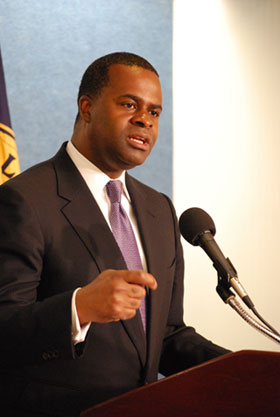 At a rally yesterday in downtown Atlanta, the Livable Communities Coalition (LCC) launched its Fair Share for Transit campaign. Speaking at the rally, Atlanta Mayor Kasim Reed voiced his support for the initiative which is designed “to explain the benefits of and need for significantly increased investment in transit service for the metro Atlanta region.”
At a rally yesterday in downtown Atlanta, the Livable Communities Coalition (LCC) launched its Fair Share for Transit campaign. Speaking at the rally, Atlanta Mayor Kasim Reed voiced his support for the initiative which is designed “to explain the benefits of and need for significantly increased investment in transit service for the metro Atlanta region.”
Atlanta is in the process of identifying major transportation projects for the region for the next decade, and Fair Share for Transit wants to make sure transit, bicycle and pedestrian projects are included. LCC Executive Director Ray Christman explained these transportation choices will help Atlanta economically: “We have to invest now in transportation alternatives that will boost the region’s economic competitiveness, help attract good jobs and improve the region’s quality of life.” Fair Share for Transit backers include private business groups and representatives of the health, disability, social equity, environmental, transit, bicycling and pedestrian communities. More than 20 businesses and groups have signed on to the campaign to date.
 The Georgia General Assembly recently passed the Transportation Investment Act of 2010, and next summer residents of Atlanta’s 10-county region will vote whether to raise sales taxes one percent for 10 years in order to finance a number of much anticipated and much needed transportation projects. According to the Atlanta Journal-Constitution, today “is the deadline for MARTA, the Atlanta region’s 10 counties and its cities and towns to get their desired projects to the state.” MARTA is not expected to set priorities until this summer, after the projects are initially reviewed by the state Department of Transportation’s director of planning and area elected officials. The campaign will continue until October 15th, when the final list of projects is announced.
The Georgia General Assembly recently passed the Transportation Investment Act of 2010, and next summer residents of Atlanta’s 10-county region will vote whether to raise sales taxes one percent for 10 years in order to finance a number of much anticipated and much needed transportation projects. According to the Atlanta Journal-Constitution, today “is the deadline for MARTA, the Atlanta region’s 10 counties and its cities and towns to get their desired projects to the state.” MARTA is not expected to set priorities until this summer, after the projects are initially reviewed by the state Department of Transportation’s director of planning and area elected officials. The campaign will continue until October 15th, when the final list of projects is announced.
Fair Share for Transit supporters include Atlanta Bicycle Coalition, Atlanta Neighborhood Development Partnership, Buckhead Community Improvement District, Cherokee Area Transportation System, Citizens for Progressive Transit, CHA, Coalition for the People’s Agenda, Atlanta Chapter of the Congress for the New Urbanism, Georgia Chapter of the Sierra Club, Georgians for Passenger Rail, Georgia STAND-UP, Georgia Transit Association, Hedgewood Realty, Henry County Chamber of Commerce, Resources for Residents and Communities of Georgia, RouteMatch Software, Southern Environmental Law Center, and Sustainable Solutions Georgia.
Formed in 2005, the Livable Communities Coalition is the Atlanta region’s smart growth advocate and catalyst. It unites nearly 60 organizations working to change the way metro Atlanta grows by focusing on land use, transportation, housing, and conservation of open green space and natural resources. Member organizations include regional leaders in the areas of aging, building and development, business, urban and landscape design, government, housing, planning, sustainable development, the environment, and transit and transportation alternatives.





 The Georgia General Assembly recently passed the Transportation Investment Act of 2010, and next summer residents of Atlanta’s 10-county region will vote whether to raise sales taxes one percent for 10 years in order to finance a number of much anticipated and much needed transportation projects. According to the
The Georgia General Assembly recently passed the Transportation Investment Act of 2010, and next summer residents of Atlanta’s 10-county region will vote whether to raise sales taxes one percent for 10 years in order to finance a number of much anticipated and much needed transportation projects. According to the 
